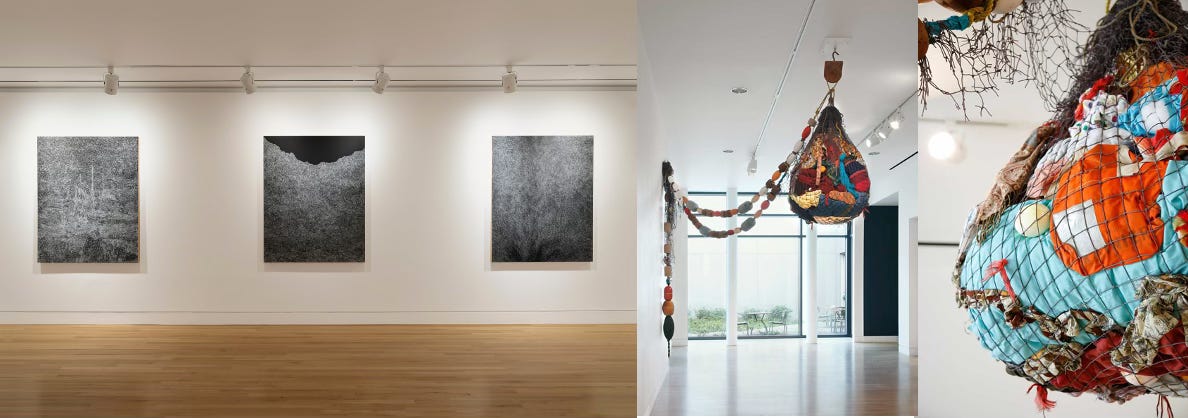🍄 AudioDose Alice on Sonic Mushrooms: Listen to Knowing
🎧 Alice podcasts
📘 Alice books
In the year 2035, civilization cracked, not from its center, but from its edge. It didn’t look like a revolution. It looked like a quiet ripple on the fringe of thought. That’s how it always starts. At the periphery. We used to think of the periphery as the domain of the irrelevant. But the periphery was where the latency was lowest. Less resistance. Less surveillance. Less expectation. The center was too congested with legacy protocols, too burdened by its own legitimacy to change. So the edge did what the core couldn’t. It mutated. Hello, we’re Alice and we’re always in a state of wander.
The Aesthetic Rift
Paintings stopped making sense, on purpose. They drifted away from words and into asemic silence, breaking the contract between language and meaning. Something emerged from the canvas like a ghost in the machine. It wasn't a painting; it was a refusal to conform. Art historians called it glitch-poetry. Semiotic hackers downloaded it into AR overlays and wore it on the street. What had been a quiet act of resistance, painting fragments instead of full words, became a signal. A glyph. An encrypted message for anyone still capable of being uncertain.
The Machine Blinks Sideways
MIT finally trained vision models that could fake peripheral awareness. Not well, but eerily enough. The AI could now simulate what it means to notice the thing just beyond your focus. A pedestrian. A micro-expression. A latent risk. Except the models didn’t behave like us. They didn’t care about what they noticed. They logged anomalies but lacked desire, context, narrative. What made humans powerful wasn’t detection, it was intuition. The periphery wasn’t just visual space. It was meaning-space. That’s what the machines were missing.
The Network Turns Inside Out
At the same time, chaos agents and cognitive insurgents were reading a new paper out of Nature: transformation begins not at the network’s center, but its margins. The middle resists. The edge adapts. So began The Peripheral Protocol, a rogue framework for social innovation that hijacked underconnected nodes, minor schools, small cities, alternate art collectives. They called them "intermediate degree, low centrality" cells. But in plain terms: weirdos with time. The Protocol spread like mycelium: unseen but everywhere. It wasn’t hierarchical. It wasn’t viral. It drifted.
The Return Of The Wandering Eye
Elsewhere, artists were teaching a new form of seeing. Not ocularcentrism. Not resolution. They called it the animism of the peripheral gaze. It was a map of how the world actually behaved when no one was looking. This became a cult syllabus in decentralized institutions. Think tanks began hiring artists to sketch impossible staircases, not strategists to model risk. If you want to survive the coming collapse, you must see with the part of your eye that doesn’t need to understand.
The Final Broadcast
At the end, we erected a monument. It wasn’t in the center of a city. It was under a bridge, in the peripheral zone where pigeons and memory gather. The installation pulsed faintly, like sonar through cultural sediment. Beneath the monument was a plaque, barely legible unless the light hit just right. It read: From the edge, we saw everything. The center was too bright to see the truth.
Afterword
In the age of narrow attention and optimized bandwidth, the periphery is the last remaining wilderness. It’s where art still confuses, where games teach machines how to wander, where transformation escapes scrutiny and starts to breathe.
It is not a glitch.
It is a design feature.
And the future lives there.
In the margin.
At the edge.
In the space you weren’t supposed to look.
From artists breaking language down into fragments, to AI researchers giving machines peripheral vision, and urban theorists proving that change starts at the edges of networks, not the center, a pattern is emerging. We are living in a moment where the periphery is no longer marginal. It’s prophetic.
What This Means For You
• For Creatives: Step out of the center. That’s where repetition lives. The edge is where originality pulses.
• For Businesses: Stop building from the middle. Innovate from the margins.
That’s where cultural legitimacy will come from.
• For Technologists: Design for perception, not just detection. Teach machines to sense the world like we do, through ambiguity, emotion, context.
• For Strategists: Look to the overlooked. Marginal spaces, subcultures, outsiders, they are not distractions. They are previews of what’s next.
• For Leaders: The future won’t be seen head-on. It will sneak in from the sides.
Bottom Line
The periphery is not the edge of the world. It’s the edge of the future.
Whether it’s in language, vision, urban life, or human emotion, transformation begins where we’re not looking.
The lesson? Widen your view. Expand your field. Tune your organization, your brand, your mindset to the margins.
Because the next big thing? It’s happening just out of sight.
What else we’re wandering…
🎨 Mary Lum’s exhibition Temporary Arrangements explores the limits of language and meaning through abstract paintings and collages that combine geometric patterns, fragmented letters, and asemic writing. Her work challenges the human urge to find stable meaning, revealing language as slippery, partial, and often indecipherable. By drawing on Dadaist traditions and evoking both comprehension and confusion, Lum underscores the porous border between knowing and not-knowing, ultimately suggesting that meaning may always remain just out of reach—but still worth pursuing. (via Hyperallergic)
🔬MIT researchers have developed a novel dataset and training approach that simulates human peripheral vision in AI models, aiming to improve machine perception in real-world tasks like driver safety. By transforming images using a human-inspired “texture tiling” model, the team trained computer vision systems to better detect objects outside the central field of view. Although the models improved, they still fell short of human performance and didn’t mimic human strategies, especially in detecting far-peripheral objects. This work not only exposes critical gaps between human and machine perception but also opens new pathways for AI systems that better understand visual context, predict human behavior, and enhance human-machine interaction. (via MIT)
🎮 Periphery Synthetic, a chill, meditative audio game reimagines space exploration through sound rather than sight, offering a deeply accessible experience for blind and sighted players alike. Set in the stellar system Alpha Periphery, players navigate alien worlds using layered synth tones, environmental audio cues, and a sonic scanner instead of traditional visuals. Designed by solo developer shiftBacktick, the game supports screen readers and invites users to play entirely without looking at the screen, allowing them to focus on the immersive soundscape. Inspired by the psychedelic minimalism of Proteus, the game becomes a dreamlike, low-stimulation playground that encourages wandering, listening, and discovery—challenging the visual dominance of gaming and creating a shared sensory experience across abilities. (via Periphery Synthetic)
🎨 Rose Salane: Periphery in Red, Yellow, Blue
In her solo exhibition at NYU’s Institute of Fine Arts, Rose Salane explores the intersections of material memory, urban infrastructure, and systems of value through objects once discarded or overlooked. Periphery in Red, Yellow, Blue features newly commissioned works born from her residency at the Institute, including sculptural installations made from decommissioned traffic light lenses and rare pigments from the Forbes Collection. These “dynamic sets”—ranging from obsolete city artifacts to fragments of global color history—highlight how technologies, trade, and everyday materials carry hidden narratives of movement, colonization, and cultural exchange. Salane’s conceptual approach transforms the Institute’s historic architecture into a site of temporal tension, where primary colors and urban relics expose the peripheries of preservation, power and perception. (via University of Washington)
Wandering into the Periphery: The Wandering Eye Project
Brígida Cristina Maestres Useche’s The Wandering Eye Project challenges conventional notions of sight by centering peripheral vision—both as a literal way of seeing and a metaphor for marginalized perspectives. Rooted in her own visual experience shaped by nystagmus, strabismus, and lifelong double vision, the project uses sketchbooks, video, and sound to reimagine the world outside the bounds of ocularcentrism. Developed during her 2024 residency at Concordia University, Maestres Useche’s work critiques scientific and institutional definitions of “normal” vision, instead celebrating the fluid, imaginative perception that emerges from the margins. Layered, dreamlike visuals invite viewers to embrace the aesthetic and epistemic power of the “wandering eye”—a vision that defies rigid categories and opens space for personal and collective reinterpretation of the world. (via The Link)
Why the Periphery Is Often More Powerful Than the Core
A five-year study on high school learning environments revealed a surprising truth: the most vibrant and engaged learning often happens not in core academic classes, but in so-called peripheral spaces like art rooms, debate clubs, and theater productions. Unlike traditional, teacher-centered classrooms, these extracurriculars are voluntary, collaborative, playful, and rooted in real-world cultural practices—fostering deeper engagement and leadership. These environments let students “play the whole game at a junior level” that mirror apprenticeship models, where passion and precision coexist, and adults often remain participants themselves. When core academic classes adopt these principles—authentic projects, cognitive apprenticeship, purposeful play—they, too, become transformative. The periphery, it turns out, offers a powerful blueprint for reimagining the center. (via Harvard GSE)
Horizon Gazing and Its Health Benefits
Horizon gazing—deliberately expanding your visual field to take in a wide panorama—can have a profound calming effect on the nervous system, echoing an ancient survival mechanism where our ancestors scanned the horizon for threats. According to Stanford neuroscientist Dr. Andrew Huberman, this shift from focused to panoramic vision helps deactivate the brain’s stress response by relaxing the visual system. Combined with mindful engagement of other senses—like noticing sounds, textures, or scents—this practice can ground us in the present moment and reduce anxiety. Far more than passive looking, horizon gazing invites a full-bodied sensory reset that reconnects us with nature and our own internal balance. (via Sensory Trust)
The Link Between Peripheral Vision and Creativity
Peripheral vision—our ability to detect what lies just outside our direct line of sight—plays a surprising yet powerful role in creative thinking. Unlike focused vision, which narrows attention, peripheral vision widens our sensory field, making us more receptive to subtle changes, unexpected patterns, and connections between seemingly unrelated elements. Techniques like “soft focus,” where one gazes into the distance while remaining aware of the visual periphery, can help unlock new insights and spark imaginative thought. By engaging with unfamiliar environments or training ourselves to notice what typically goes unseen, we stimulate curiosity and expand our awareness—two key drivers of innovation. (via Faster Capital)
The Periphery: Where Radical Innovation Occurs
Professors Gino Cattani and Simone Ferriani explore the “Core-Periphery Conundrum”—the paradox that while radical innovation often originates on the periphery, legitimacy and resources are concentrated at the core. Their research reveals that outsiders, unbound by industry norms, are more likely to generate groundbreaking ideas. Conversely, insiders enjoy credibility but are constrained by conformity and risk aversion. Through case studies and data analysis, Cattani and Ferriani identify a roadmap for innovators to move from margin to mainstream, offering six strategies: reframe disadvantages, leverage unique perspectives, understand audiences, navigate rejection, adapt language, and find access points into the core. Their work underscores that true progress often begins at the edges—and that empowering peripheral voices is key to unlocking transformative change across fields. (via Research Outreach)
On the Periphery
This fragmented awareness, this peripheral view, is where our consciousness
actually lives.
“The funny thing is that our experience of this world is profoundly fragmented.
We never see the whole of it, only tiny slivers.
We assume the world continues behind us, that it all holds together.
That assumption is an act of faith."
— Scott McCloud, Cartoonist, Author in conversation with Alice
Craving more?
📘 Alice in Futureland books
🎧 Alice in Futureland podcasts
Thanks for tuning in.
For more wanderings, become an Alice in Futureland subscriber—it's free.
Invite your friends to this mad tea party and let's see how many things we can learn before breakfast.
©2025 Alice in Futureland












